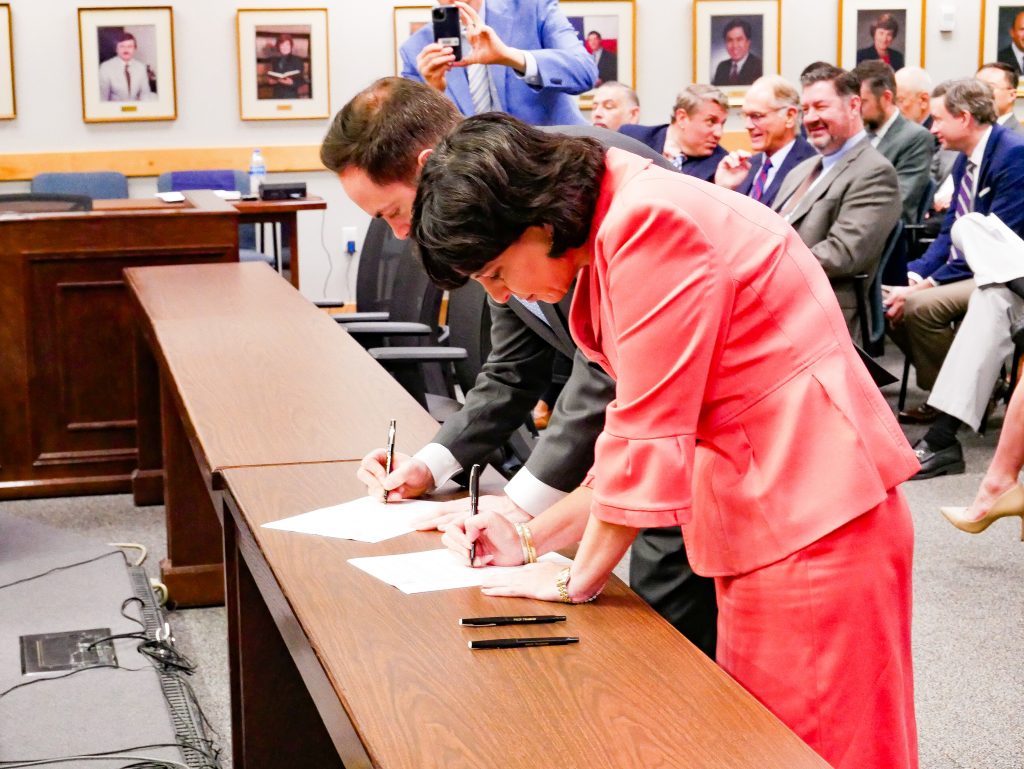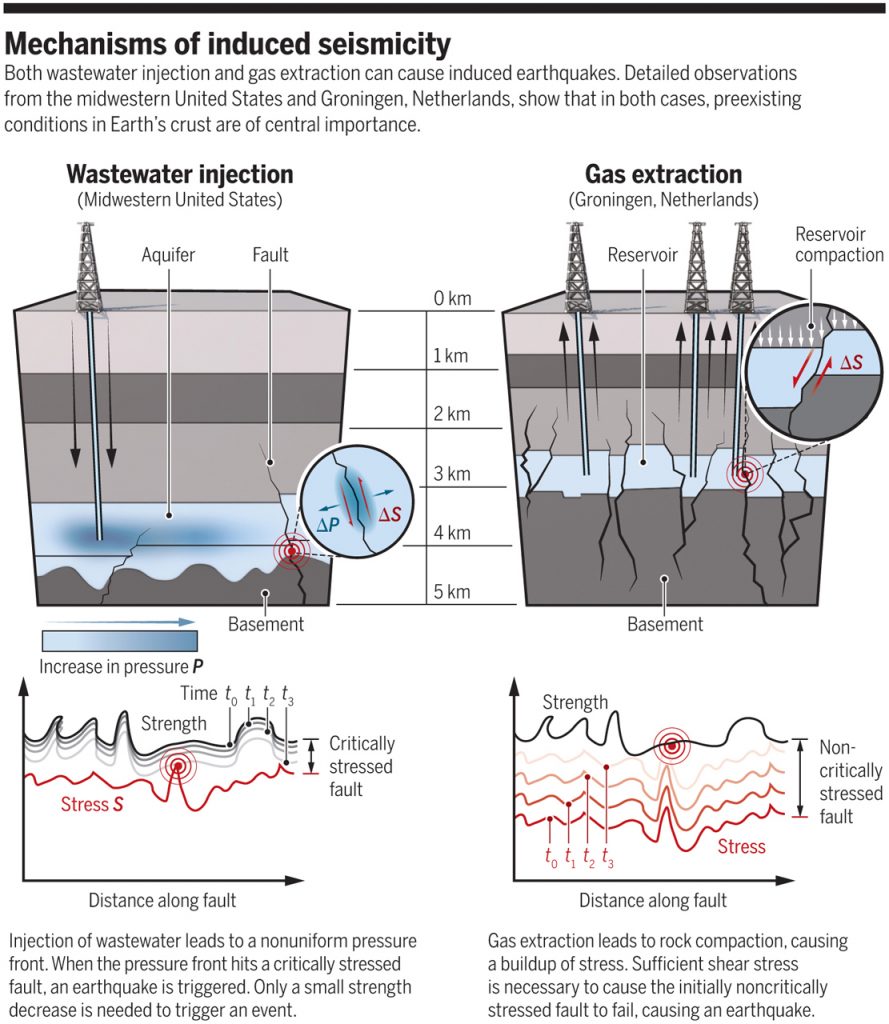Click here to listen to the Audio verison of this story!
Is Induced Seismicity a punk band or a geologic event?
If you said, “Geologic event,” you’d be correct.
If you guessed, “Punk band,” please let us know which clubs you’ve been visiting.
You are sitting at home in Midland, and you hear a truck coming down the street, which isn’t a truck, but really a train, and it isn’t down your street, exactly. It feels like mile-wide tracks are cutting across the city and your house is smack dab in the middle of it. As the train comes barreling through town, so loud you can hear it, feel it—as it comes storming down the tracks towards you—you, your house, and everything in it begins to sway and creak. It feels the way the crack of the whip travels supersonically as the curve moves through the leather but stays still. And the moment that wave crests under you—your home, the ground your home is on, everything you know—is now on a wild ride like an aircraft dropping 50 feet in a second during turbulence.
Then it’s eerily silent.
Until the next time.
The culprits for earthquakes in the region have been reduced to frac’ing and produced water disposal, with the latter far outweighing the former in the Permian Basin. However, in other regions, such as Canada’s British Columbia, the situation is reversed. Their activity is precipitated by frac operations and a very small percentage is from injection disposal wells. Every well and geology is different, even when the operations are the same.
The old saying I just made up is, “Everything is okay… until it isn’t,” and injecting produced water back underground via SWDs (Salt Water Disposal wells) isn’t so okay anymore in the Permian. The methods of produced water disposal are at a crossroads with regulations, seismicity, and cost. At this intersection await the regulators to slow this tectonic roll. Also at this intersection await the technologies and desire to turn this potentially earthquake-inducing waste product into a valuable resource.
Many a time I have written in these pages that “sustainability” is just the question of how long one can keep doing things the way they’ve been doing it. We have now reached a theoretical and realistic point where everyone recognizes that traditional produced water disposal methods will not wear well into the future. Recent events have underscored this reality and triggered the ensuing permit requirement changes enacted by Texas’ oil and gas regulating authority, the Railroad Commission (RRC), to reduce the potentiality of future quakes.
Different subsurface processes have fluids moving in different directions.
On a beautiful sunny mid-February day in West Texas the hoped-against became real: a geological event occurred, a Magnitude 5.0 quake spurred on by salt water disposal increase in pressure in the formation, causing a slip in the fault approximately 33 miles west of Toyah, Texas, in Reeves County. A 24-inch natural gas pipeline ruptured, and flames shot into the sky. Several days later there was a 4.8 Magnitude quake. Both events quickly got the attention of the Railroad Commission.
To drive this home, during the open meeting of the RRC at the end of April, 2025, in Austin, the new Administrator for the Environmental Protection Agency (EPA) Region 6, Scott Mason, met with Chairwoman Christi Craddick, Commissioner Wayne Christian, and Commissioner Jim Wright to discuss the various issues surrounding the Permian Basin’s critical interplay of environmental and geological protection and the economic powerhouse oil and gas production engine that the region provides.
According to the RRC, a move to ensure that “injected fluids remain confined to the disposal formations to safeguard ground and surface fresh water” was achieved by the signing of a Memorandum of Agreement by both the EPA and RRC regarding the Underground Injection Control (UIC) program managed by the Railroad Commission. Beginning June 1st, 2025, several new rules came into effect: an increased area of review (AOR) at the injection site; limits on the maximum injection pressure at the surface based on geologic properties; and limits on the maximum daily injection volume based on reservoir pressure.

RRC Chair Craddick (foreground) and EPA’s Mason sign the Memorandum of Agreement.
Old and/or unplugged wells will also require an assessment to ensure produced water does not leach through those wellbores within the AOR, as radius of the AOR has now increased from a quarter to half mile from the well. Disposal reservoirs will have their pressures monitored, and that will determine the limits on maximum volumes that SWDs can inject into those formations. Given the concern that seismicity is caused by water entering fissures and increasing pressures at faults, operators must provide reporting that their injection pressure will not fracture the reservoir the water is being injected into.
This is all well and good for the future in attempting to reduce seismic activity in the region. Whether these changes will yield results remains to be seen, and there have been some notable reductions (see below), but the Railroad Commission and Environmental Protection Agency, now under control of the second Trump administration, have a mandate to maintain production while reducing surface and subsurface risk.
Kelly Bennett, CEO of B3 Insight, an oilfield water intelligence consultancy, remarked, “I think we all agree that the cost of water management is going to have to increase in order to provide a means to transport water away from these areas that are problematic.” Indeed, the reduction in seismic activity in Northern Culberson-Reeves counties has been dramatic over the last several years with the reduction in maximum pressure for those disposal reservoirs. However, the need to move water from one place to another also adds to the costs of oilfield water management infrastructure.
While produced water treatment has been covered in these pages recently, the use of seismic monitoring has also taken a new turn. In contrast to the business of forensically locating geologic activity, there now exists a positive, productive application of seismicity. One company in particular is bringing this technology to the front end of the deal by assisting operators in fine-tuning their drilling operations in real time. Microseismic Inc. uses an array of buried sensors to detect the frac’ing of the formation during operations. By utilizing multiple sensors and pinging the signal back to the point of origin, the array can pinpoint each fractured fissure and provide a 4D image of deep underground extractions. In a process similar to the way two lighthouses can triangulate the position of a vessel, the buried arrays return signal to the origin point and then the vectors are plotted and where the array signals cross—this is the origin of the event. Operators can see individual reservoir rocks breaking open and adjust on the fly to conditions deep below the surface.

There is more than one cause of induced seismicity.
Oil and gas production in the Permian Basin will not cease. The return of produced water will not cease, either. The places we have been disposing of the water underground are becoming potentially over pressurized. The long-haul transport of produced water will also quickly become an expense that not many, other than the largest operators, can bear.
It is not coincidental that as one side of the industry is dealing with limitations of a wastewater disposal, some of the same players are also looking for the inflection point where produced water is now ready for beneficial reuse outside of its recycled brethren within the industry.
Even with new guidelines from the Railroad Commission, support from the EPA, and technological advances from operators and other firms, chances are high the Permian Basin will continue to experience some level of tremors and earthquakes. We are moving towards better understanding the formations using new technologies to conserve the reservoir geophysical integrity by not over pressuring and causing secondary geologic effects. As we continue Injecting produced water back into the formations for disposal or enhanced oil recovery techniques, the only remaining question about induced seismicity is:
What venue are they playing next month?
Christian Lombardini is Executive Director of the Energy Communicators Association, founder and host of The Oilfield Leader Podcast, speaker, and oilfield veteran. He lives in Midland, Texas, with his family. Follow him on LinkedIn for more.
The post Getting Grounded on the Seismicity Issue appeared first on Permian Basin Oil and Gas Magazine.
pboilandgasmagazine.com (Article Sourced Website)
#Grounded #Seismicity #Issue
